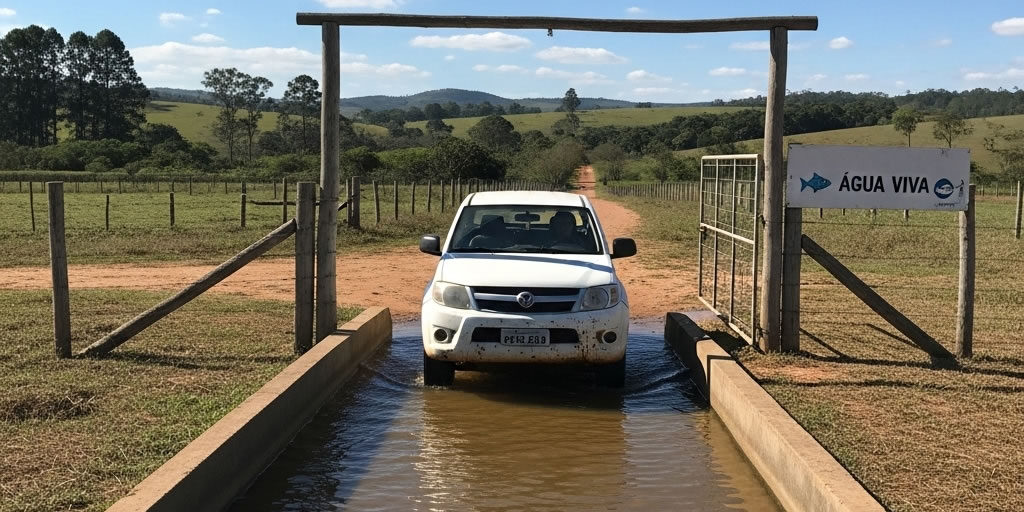- Software Gestor para Aquicultura
- (85) 2139-6730
- contato@despesca.com.br
10 Essential Precautions During Fish Harvesting to Ensure Seafood Quality

Cost Per Pound of Fish: The Question Your Paper Notes Can’t Answer
01/10/2025
Correct Pricing for Aquaculture: Calculate Your Fish and Shrimp Prices
06/10/2025Fish harvesting represents the culmination of months of work and investment. However, it is at this final stage that product quality can be irremediably compromised. Inadequate handling during the harvest results in stress for the animals, physical injuries, and consequently, significant economic losses due to product depreciation. Therefore, adopting essential precautions during fish harvesting is not just a good practice, but a strategic necessity for any producer aiming for excellence and maximum profitability.
Below, 10 critical points are detailed that must be rigorously observed to ensure that the fish or shrimp reaches the consumer with the superior quality that the market demands.
1. Detailed Operation Planning
First and foremost, the harvesting operation must be meticulously planned. This involves defining the necessary team, checking all equipment (nets, crates, scales, ice), logistics for transport, and communication with the buyer. A disorganized operation is the first step towards failure, as it causes delays and increases the animals’ exposure time to adverse conditions. Consequently, a well-executed plan minimizes unforeseen events and optimizes the entire process.
2. Strategic Fasting of Animals
It is crucial to subject the animals to a fasting period before harvesting. For most fish, a period of 24 to 48 hours is ideal. This procedure reduces the animals’ metabolic rate, decreasing oxygen consumption and waste production during handling. Furthermore, an empty digestive tract prevents meat contamination during evisceration, a crucial factor for food safety and product shelf life.
3. Choosing the Ideal Time
Harvesting should preferably be carried out during the coolest hours of the day, such as early morning. Milder temperatures reduce thermal stress in the animals and, equally important, slow down microbial proliferation. Performing the harvest under strong sunlight raises the water temperature and that of the animals themselves, accelerating the post-mortem deterioration process.
4. Careful Pre-Capture Handling
The moment preceding capture is one of high tension for the animals. Therefore, any movement must be done calmly and gradually. Avoiding excessive noise and sudden movements in the water helps keep the animals less agitated. A cultivation environment with stable water parameters, continuously monitored, also contributes to the animals reaching this moment in better physiological conditions.
5. Use of Appropriate Equipment
The choice of capture equipment is critical for the physical integrity of the fish. Nets made of smooth material and without knots should be used to prevent scale loss and skin lesions. Similarly, initial transport containers (scoop nets, buckets) must be appropriate to avoid bruises from impact or compression.
6. Rigorous Hygiene of Materials and Personnel
Biosecurity does not end with the grow-out cycle. On the contrary, it is intensified during harvesting. All crates, tarpaulins, equipment, and utensils that will come into contact with the fish must be thoroughly cleaned and sanitized beforehand. The involved team must follow good personal hygiene practices to avoid cross-contamination. This care is a pillar for ensuring a safe and high-quality product. To delve deeper, reading about Aquaculture Biosecurity is highly recommended.
7. Humane Slaughter by Thermal Shock
The most effective and recommended method for fish slaughter is thermal shock. This process involves the immediate immersion of animals in a mixture of water and ice (in a 1:1 ratio) at a temperature close to 0°C. Thermal shock promotes rapid loss of consciousness, being considered a humane method. Additionally, the low temperature instantly initiates product cooling and delays rigor mortis, resulting in firmer-textured and better-quality meat.
8. Uninterrupted Maintenance of the Cold Chain
After slaughter, maintaining the cold chain is, without a doubt, the most critical factor. The fish must be kept under continuous refrigeration, in insulated boxes with good quality ice (made with potable water), until it reaches its final destination, whether a processing plant or point of sale. Any break in this chain accelerates enzymatic and microbial activity, irreversibly compromising quality.
9. Correct Classification and Packaging
Immediately after slaughter and initial cooling, the product must be classified by size (biometry) and packed into final transport crates. The fish should be arranged in layers interspersed with ice, ensuring that the entire surface is in contact with the cold. This procedure not only preserves quality but also adds value to the product, facilitating commercialization.
10. Data Recording and Traceability
Finally, recording all harvesting information is vital. Data such as date, time, batch, harvested volume, slaughter and transport temperatures, and product destination are essential for quality management and traceability, an increasingly important requirement from the consumer market and regulatory bodies.
The use of a management software, such as Despesca, automates and centralizes these records. Having precise control over each stage of harvesting allows for the identification of areas for improvement, ensures compliance with standards, and, above all, proves the superior quality of your product, strengthening your brand in the market.



